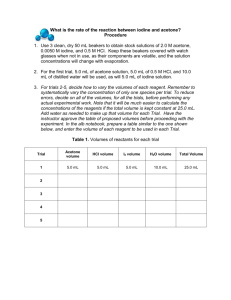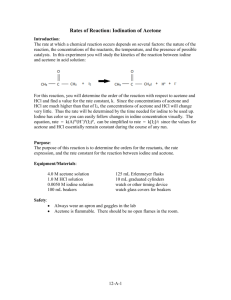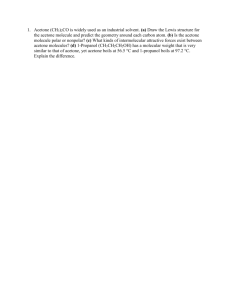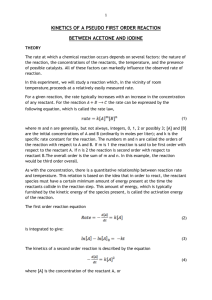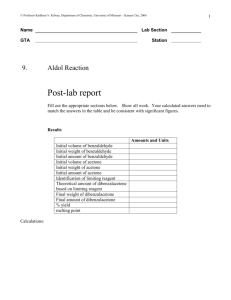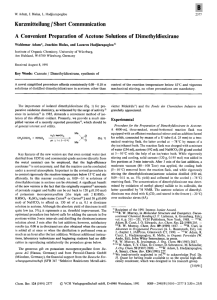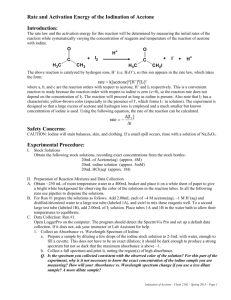Acetone-Iodine Reaction Kinetics Lab
advertisement
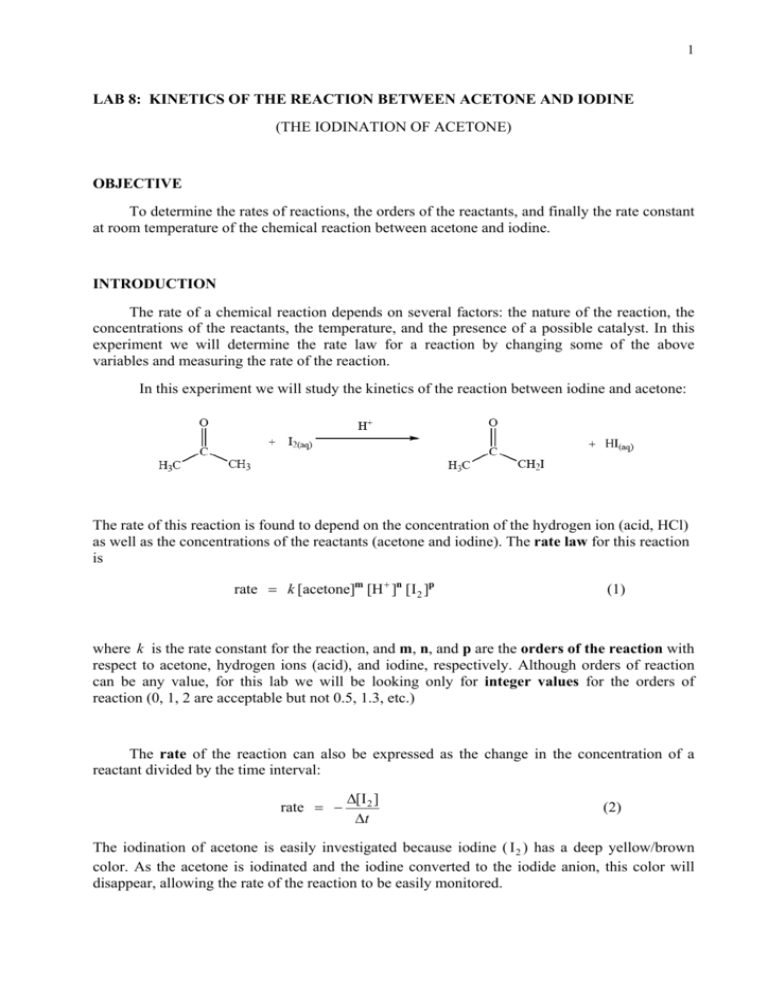
1 LAB 8: KINETICS OF THE REACTION BETWEEN ACETONE AND IODINE (THE IODINATION OF ACETONE) OBJECTIVE To determine the rates of reactions, the orders of the reactants, and finally the rate constant at room temperature of the chemical reaction between acetone and iodine. INTRODUCTION The rate of a chemical reaction depends on several factors: the nature of the reaction, the concentrations of the reactants, the temperature, and the presence of a possible catalyst. In this experiment we will determine the rate law for a reaction by changing some of the above variables and measuring the rate of the reaction. In this experiment we will study the kinetics of the reaction between iodine and acetone: The rate of this reaction is found to depend on the concentration of the hydrogen ion (acid, HCl) as well as the concentrations of the reactants (acetone and iodine). The rate law for this reaction is rate = k [acetone]m [H + ]n [I 2 ]p (1) where k is the rate constant for the reaction, and m, n, and p are the orders of the reaction with respect to acetone, hydrogen ions (acid), and iodine, respectively. Although orders of reaction can be any value, for this lab we will be looking only for integer values for the orders of reaction (0, 1, 2 are acceptable but not 0.5, 1.3, etc.) The rate of the reaction can also be expressed as the change in the concentration of a reactant divided by the time interval: rate = − Δ[I 2 ] Δt (2) The iodination of acetone is easily investigated because iodine ( I 2 ) has a deep yellow/brown color. As the acetone is iodinated and the iodine converted to the iodide anion, this color will disappear, allowing the rate of the reaction to be easily monitored. 2 We can study the rate of this reaction by simply making I 2 the limiting reactant in a large excess of acetone and H + ion. By measuring the time required for the initial concentration of iodine ( I 2 ) to be used up completely, the rate of the reaction can be determined by the equation rate = − [I ] ( [I ] − [I 2 ]initial ) ( 0 − [I 2 ]initial ) Δ[I 2 ] = − = − 2 final = 2 initial Δt tfinal − tinitial tfinal − 0 tfinal (3) or simply as rate = [I 2 ] time (4) From the rate information we can determine the orders with respect to acetone (m), acid (n) and iodine (p) by varying the amounts of reactants and measuring the effect on the rate. Once the orders of reaction are known, we will be able to calculate the rate constant, k . PROCEDURE: Finding the rate, orders of reaction and rate constant at room temperature. 1. For each trial listed below: • Into a 125-mL conical flask; measure the 1.0 M HCl, 4.0 M acetone, and distilled water using a 10-mL graduated cylinder. • Into a 25-mL beaker; measure the 0.005 M I 2 solution using a 10-mL graduated cylinder. 2. Start the stopwatch as you pour the 0.005 M I 2 solution into the 125 mL flask. Swirl the flask (which helps to prevent acetone evaporation) until the yellow color disappears, then halt the stopwatch. It may help to place the flask on a white piece of paper to help discern when the color disappears. Record the time elapsed in seconds. 3. Repeat this reaction mixture until two trials are within 20 seconds of each other. Determine the average time elapsed in seconds for this trial. 4. Repeat this process for each of the four trials listed in the table below. In a 125-mL conical flask Trial 1 2 3 4 1.0 M HCl (mL) 5 5 5 10 4.0 M acetone (mL) 5 5 10 5 distilled water (mL) 10 5 5 5 In a 25-mL beaker 0.005 M I2 (mL) 5 10 5 5 3 Example: How do you prepare a 150 mL of a 4.0 M acetone solution from the pure liquid? Acetone (CH3COCH3): density (at 20°C) = 0.790 g/mL; M.W. = 58.08 g/mol • For 150 mL of 4.0 M acetone solution, you will need 0.6 mol of acetone, which is 34.85 g of acetone, and with a density of 0.790 g/mL). You will need 44.11 mL of pure acetone. Assuming the rest is water. • You will add 44.11 mL of pure acetone to 106 mL of water (or whatever). 0.15 L × 4.0 M = 0.6 mol × 58.08 g/mol 0.15 L × 4.0 M = 34.85 g 34.85 g / X mL = 0.790 g/1mL D X = 44.11 mL 150 mL – 44.11 mL ≈ 106 mL CALCULATIONS: 1. Determine the concentration of each reactant (acetone, HCl and iodine) in each reaction mixture. Example: Determine the concentration of iodine in Trial #1. Solution: Using the relation M1V1 = M2V2 let M1 = initial (undiluted) concentration of iodine (0.0050 M), V1 = 5.00 mL (of undiluted iodine added to the mixture), and V2 = 25.00 mL (the total volume of the diluted solution once HCl, acetone and water are added). Solving for M2, the concentration of iodine in the diluted solution, one gets: M2 = (0.0050 M × 5.00 mL) / 25.00 mL = 0.0010 M which is the concentration of iodine used in the reaction in Trial #1. Example: Determine the concentration of iodine in Trial #2. Solution: Since M1 and V2 are the same as in the previous example, we see that only V1 has changed to 10.00 mL. Rearranging for M2 as before: M2 = (0.0050 M × 10.00 mL) / 25.00 mL = 0.0020 M which is the concentration of iodine used in the reaction in Trial #2. 4 2. Average each pair of times for each trial then calculate the rate of the reaction. Example: Trial #1 required an average of 240 seconds to go to completion. Trial #2 required an average of 496 seconds to go to completion. Find the rate of reaction for both Trial #1 and Trial #2. Solution: The rate of reaction is equal to the concentration of iodine divided by the time elapsed (see the introduction section for more details; DO NOT use [HCl]/time or [acetone]/time in this lab). Using the concentrations from the above examples, we can calculate rate thusly: rate (Trial #1) = [I2]/(average time in seconds) = 0.0010 M / 240 s = 4.2×10–6 M s–1. rate (Trial #2) = [I2]/(average time in seconds) = 0.0020 M / 496 s = 4.0×10–6 M s–1. 3. Next determine the order of the reaction with respect to each reactant (m, n, and p). Example: Find the order of reaction with respect to iodine (p) using the information calculated above. Solution: Notice how in Trial #2 we doubled the concentration of [I2] while leaving the other reactants’ concentrations (HCl, acetone) unchanged. An effect upon the rate of the reaction will reflect the influence of the iodine only, and this will allow us to determine p. In these sample calculations, doubling the concentration of iodine (to 0.0020 M from 0.0010 M) spawned a negligible change in the rate (4.0×10–6 M s–1 versus 4.2×10–6 M s–1). Because we are only concerned with whole integer values of rate orders, this implies a zero order reactant, and p = 0. A more formal approach to determining p would be as follows: divide the expression for rate 2 by the expression for rate 1; this results in the following: k [acetone]m [HCl]n [I 2 ]p rate 2 = rate 1 k [acetone]m [HCl]n [I 2 ]p The values of k , [acetone] and [HCl] remain constant between Trial #1 and Trial #2 (only [I2] changes), so the expression reduces to rate 2 4.0 × 10 −6 [0.0020]p = = rate 1 4.2 × 10− 6 [0.0010]p = 2p 0.95 = 2p Taking the logarithm of both sides leads to and solving for p: p = log 0.95 log 2 log 0.95 = log 2p = p log 2 = − 0.074 ≈ 0 Therefore, the order with respect to iodine equals zero. 5 4. Calculate k for each Trial. Example: Find the value of k for Trial #1 using the values supplied above and assuming that the order with respect to acetone (m) is one and the order with respect to HCl (n) is one. Solution: Using the information in Trial #1, the diluted concentration of acetone is 0.80 M and the HCl is 0.20 M (confirm this on your own). Using the values for rate 1 and the order of iodine from above, we can calculate k from the following equation: rate = k [acetone]m [HCl]n [I 2 ]p 4.2 × 10−6 = k [0.80]1 [0.20]1 [0.0010]0 and solving for k we get a value of k = 2.6×10–5 M–1 s–1. 5. Find the average value of k and conduct a parts per thousand analysis on your k values. QUESTIONS: 1. In a reaction involving the iodination of acetone, the following reaction mixture was used: 5.00 mL of 4.0 M acetone, 5.00 mL of 1.0 M HCl, 5.00 mL of 0.0050 M I2, and 10.0 mL of distilled water. a) What was the molarity of the acetone in the reaction mixture? (Recall that M1V1 = M2V2) b) The color of the above reaction mixture disappeared in 250 seconds. What was the rate of the reaction? (Hint: First determine the initial concentration of the iodine.) 2. A second reaction mixture was made: 10.00 mL of 4.0 M acetone, 5.00 mL of 1.0 M HCl, 5.00 mL of 0.0050 M I2, and 5.00 mL of distilled water. a) What was the molarity of the acetone in this reaction mixture? b) The iodine color disappeared in 120 seconds. What was the rate of the reaction? c) Determine the order of the reaction (m) with respect to acetone using the information from question 1 and 2. (Round off the value of m to the nearest integer) 3. A third reaction mixture is made: 10.00 mL of 4.0 M acetone, 5.00 mL of 1.0 M HCl, and 10.00 mL of 0.0050 M I2. If the reaction is zero order with respect to iodine, how long will it take for the iodine color to disappear? Reference: • Chemistry 222 by Dr. Michael Russell, Mt. Hood Community College, Oregon, USA. http://classes.mhcc.edu/web/ch222_mr/pdfLabs222/KineticsPartI.pdf ,

